I am so excited to share this chocolate cherry bread with you. The loaf is scattered with dried tart cherries and toasty chunks of caramelized white chocolate.
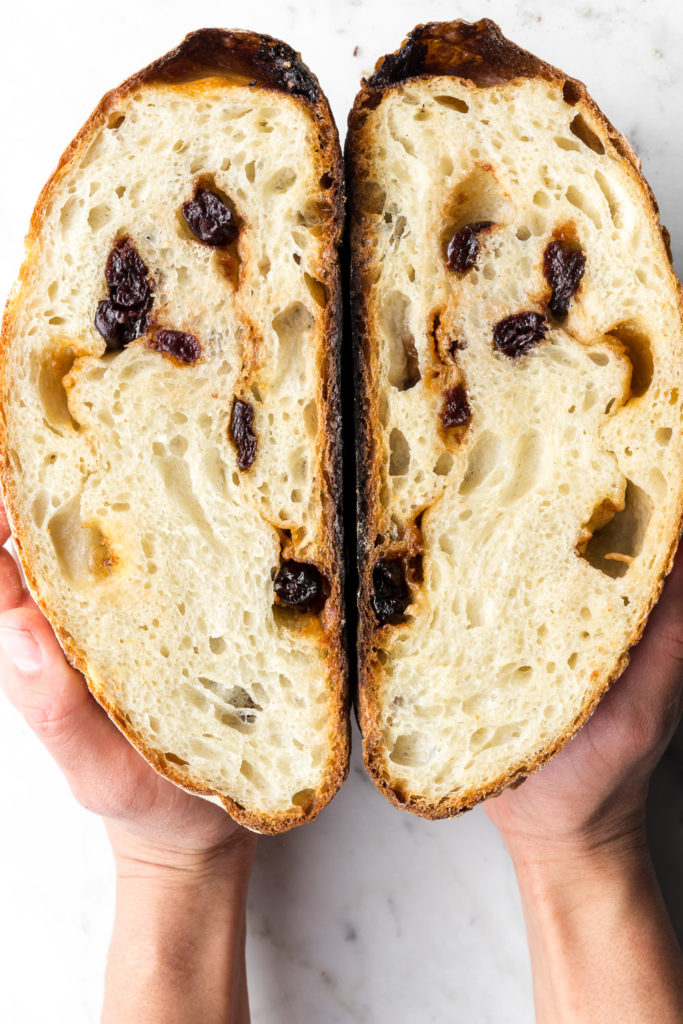
The artisan style yeast bread has a crunchy crust and is full of flavor, thanks to a Dutch oven and the fantastic bread making techniques of Ken Forkish. The recipe may looking daunting, but hang in there. Once you figure out the process (which is pretty repetitive), you'll be able to make the most amazing artisan white chocolate bread. It's chewy, crusty, sweet, tart and so satisfying.
If you’ve never had caramelized white chocolate, now’s the time to change that! It’s a toasty, nutty, toffee-flavored transformation of white chocolate that you won’t be able to get enough of.
Your friends and family are going to be blown away by this combination of flavors and textures. That is, if the bread ever makes it to them.
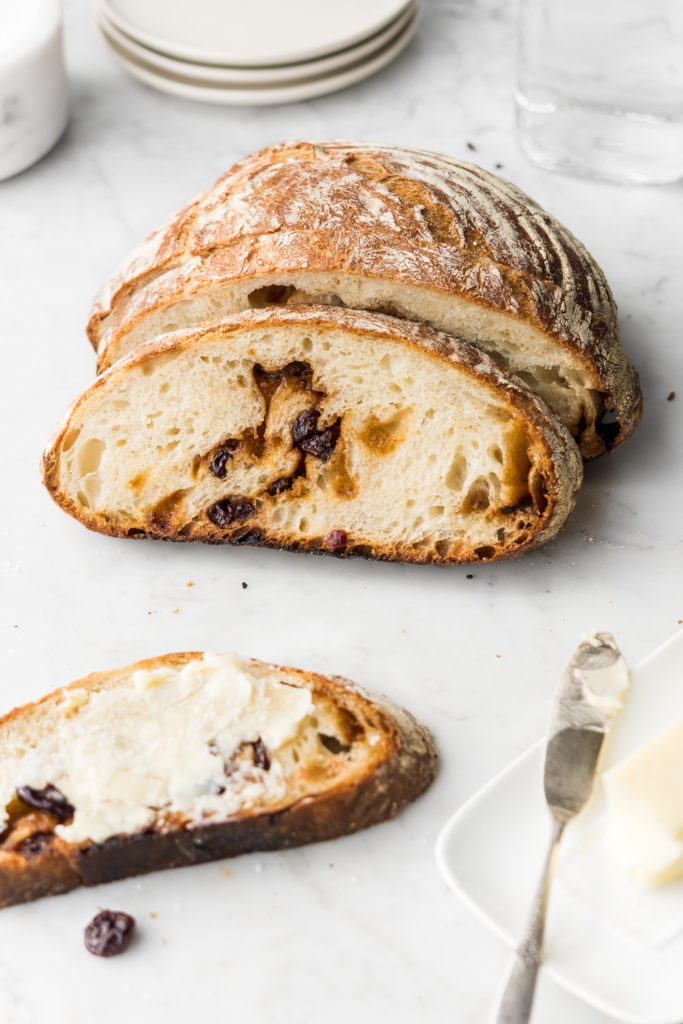
what is caramelized white chocolate?
Caramelized white chocolate is made by slowly roasting white chocolate. The milk solids (proteins and sugars) undergo a combination of caramelization and maillard reactions which produce a golden color and deliciously toasty flavors.
Think notes of caramel, butterscotch, toffee, biscuit, dulce de leche and roasted nuts. When the white chocolate cools, the texture remains creamy, smooth and luscious but it has a much more complex flavor.
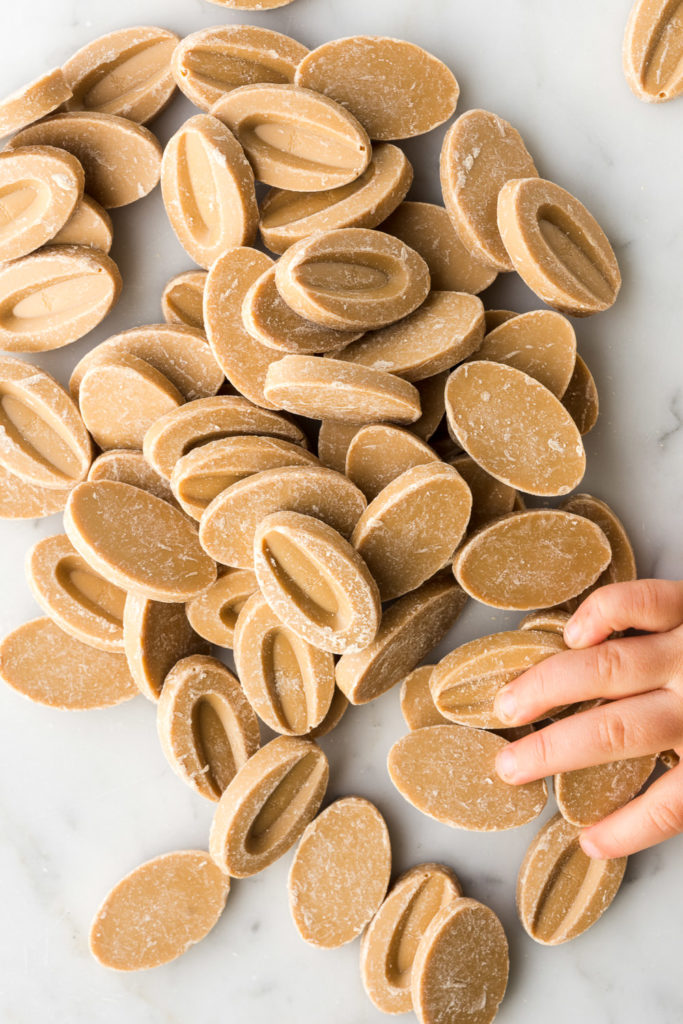
You can easily make caramelized white chocolate at home. All you need is a high quality white chocolate (at least 30% cocoa butter) and an oven. You roast the chocolate at a low temperature, stirring every 5 to 10 minutes, until it turns a rich toffee color.
David Lebovitz has a great tutorial on how to make your own caramelized white chocolate that you can see here!
And if you don’t want to make it, you’re in luck! Valhrona developed a caramelized white chocolate in 2012 called Dulcey. It’s delicious, toasty and much more consistent than anything you make at home.
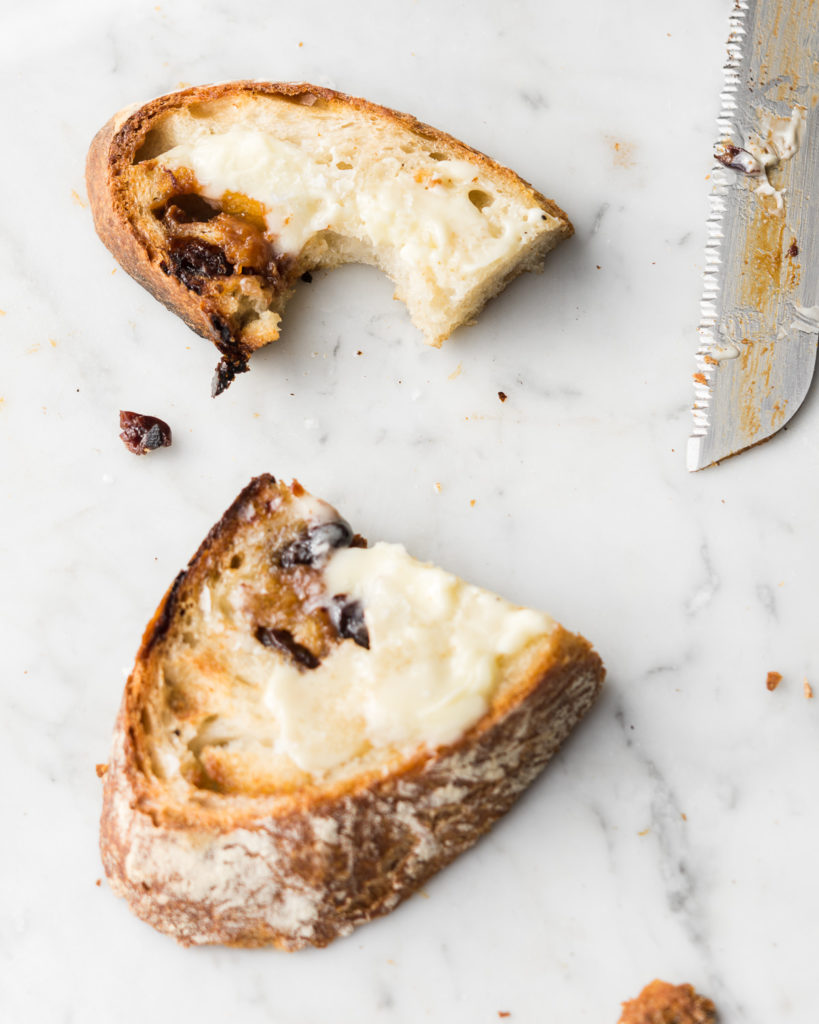
what is a biga?
A biga is a type of preferment. It’s a portion of a yeast dough that is mixed ahead of time. Flour, water and a small amount of yeast are combined and allowed to ferment for up to 12 hours before the final dough is mixed.
In general, a biga tends to be a stiffer dough than a poolish (another type of preferment), which is usually equal parts water and flour.
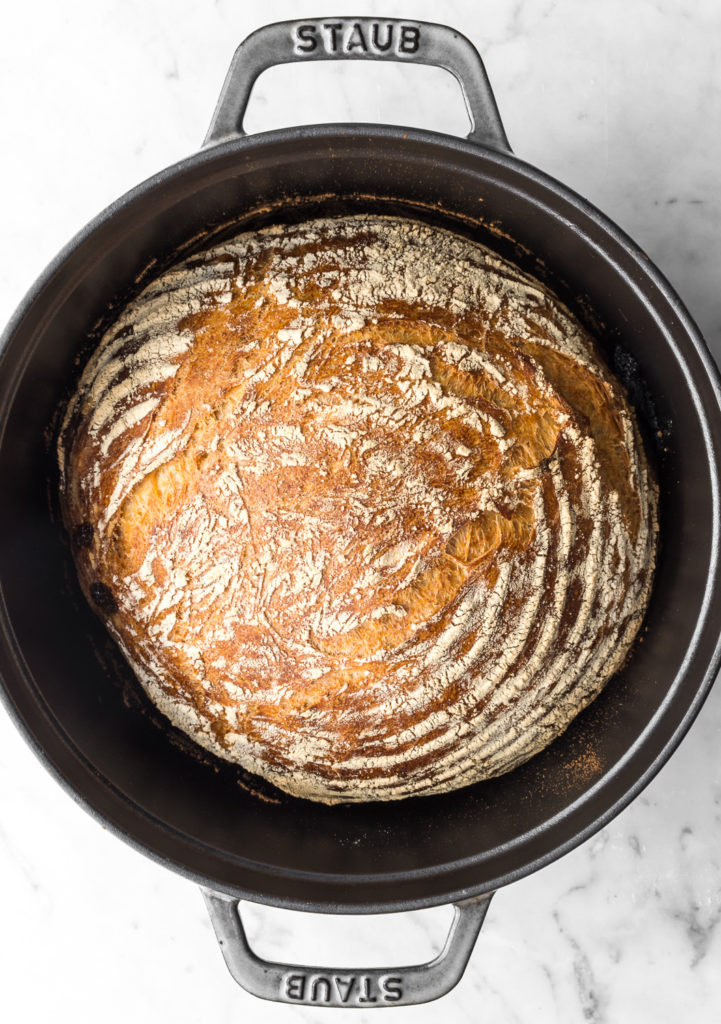
what is the purpose of a preferment?
Flavor. Simple as that. When a portion of the dough is mixed ahead of time, enzymes are activated that break down starches into sugars. This has a lot of effects.
For one, those simple sugars taste better than starch.
And two, those sugars are now available for yeast and bacteria to ferment them. That fermentation produces flavors and acidity (in addition to alcohols and carbon dioxide). This bubbly and flavorful preferment gets mixed into the final dough to add complexity.
And as an added benefit, the extra acidity from the preferment also helps the bread last longer.
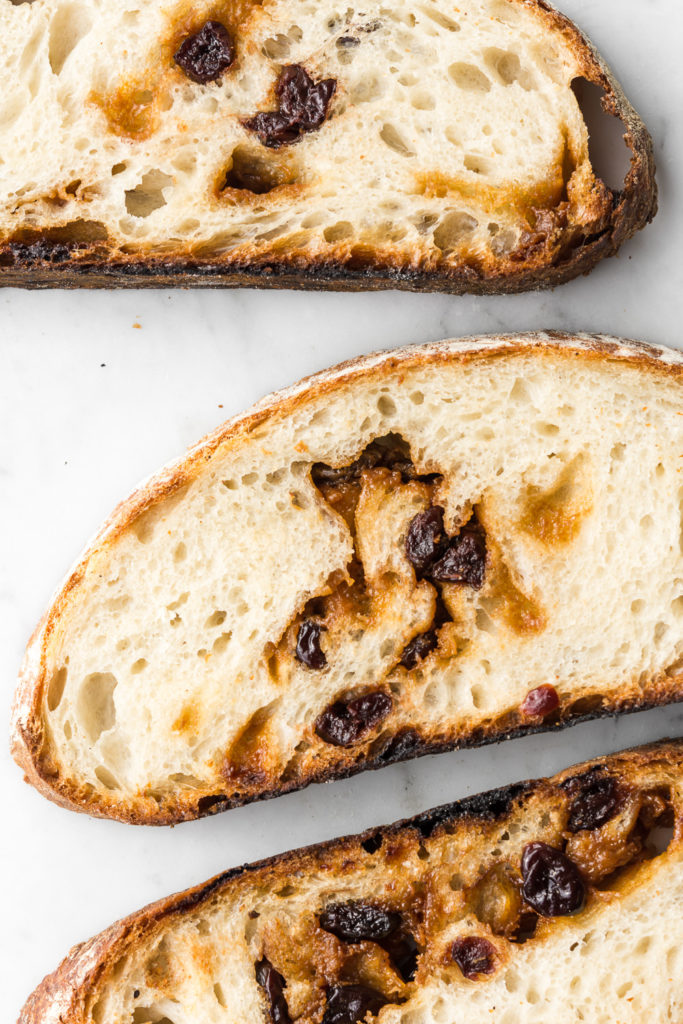
how to make white chocolate cherry bread:
- Mix the biga (flour, water and yeast) the night before you want to make the bread
- Mix up the final dough and combine it with the biga, using a pinching and folding technique
- Let the dough rest 20 minutes
- Sprinkle caramelized white chocolate and cherries over the surface of the dough. Fold the dough over the chocolate and cherries until it’s covered, then invert the dough in the bowl so the seam is down
- Let the dough rest 20 minutes
- Fold the dough over the center again, then invert the dough in the bowl so the seam is down
- Let the dough rest 20 minutes
- Fold the dough over the center for the third time, then invert the dough in the bowl so the seam is down
- Let the dough rise until triple the original size, about 3 hours after first mixing in step 2. This is the bulk fermentation.
- Preheat the oven with the Dutch oven inside Shape the dough and proof it for 1 hour.
- Carefully transfer proofed loaf to the hot Dutch oven and bake.
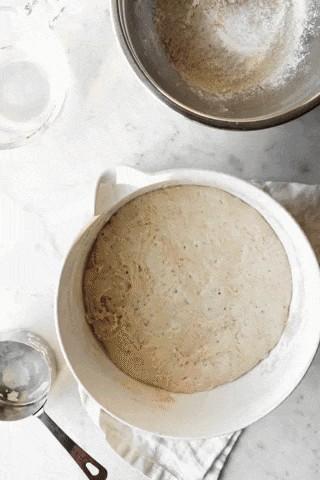
here’s a timeline for the white chocolate artisan bread:
- biga: 12-14 hours
- bulk fermentation: 2 ½- 3 hours (3 folds in first 1 ½ hours)
- proof: 1 hour
- bake: 50-60 minutes
For more details on the process for this white chocolate cherry bread, check out this post for chocolate chunk artisan bread. The process is almost identical.
Even better, check out the book Flour, Water, Salt, Yeast by Ken Forkish to really understand these techniques and why they’re so important!
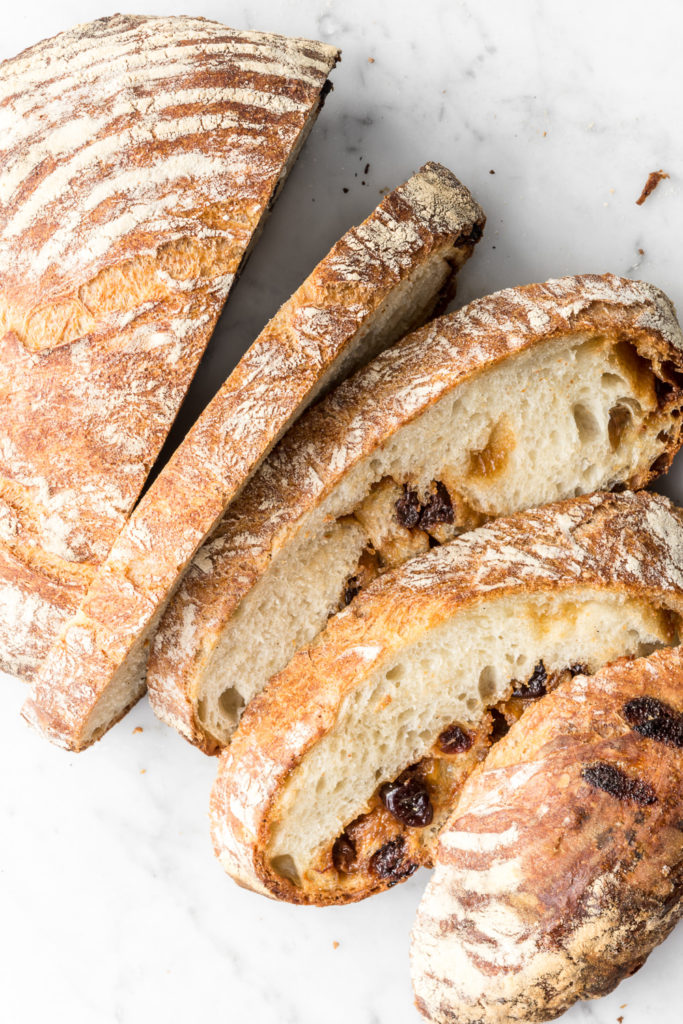
related recipes
no churn oatmeal ice cream with sour cherry swirl
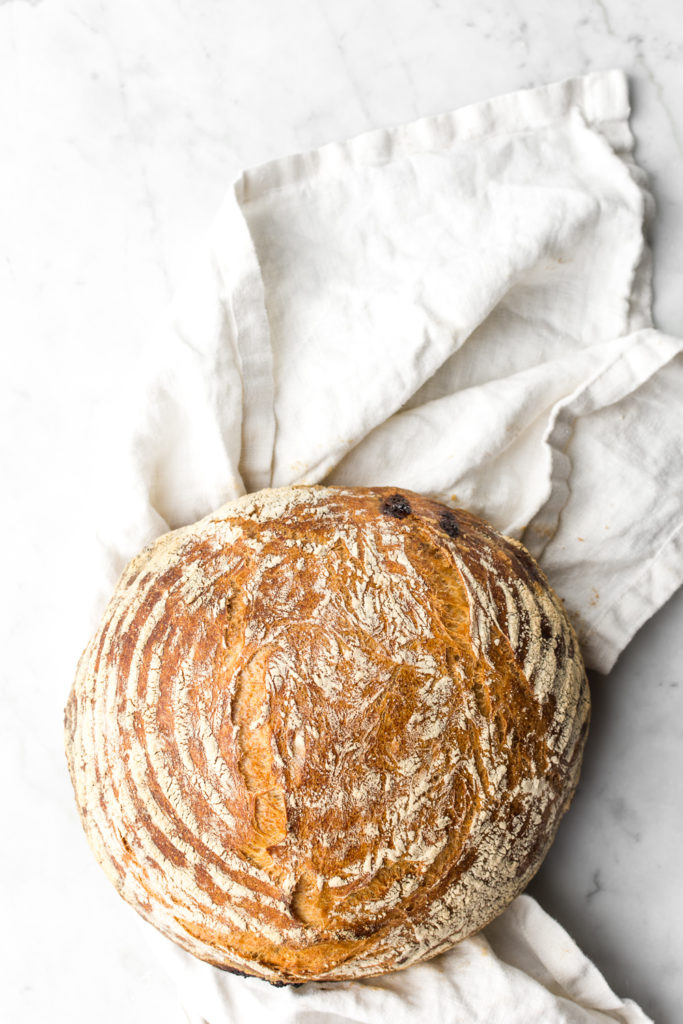
caramelized white chocolate cherry bread
This chocolate cherry artisan yeast bread is crunchy, chewy, and addictive. It’s filled with tart cherries and toasty chunks of caramelized white chocolate!
- Prep Time: 1 hour
- Cook Time: 1 hour
- Total Time: 2 hours
- Yield: 1 loaf
- Category: Bread
- Method: Baking
- Cuisine: American
Ingredients
biga
- 3 cups + 2 tbsp (400 g) all-purpose flour
- 1 cup + 2 tbsp + 2 tsp (272 g) warm water
- ⅛ tsp (0.5 g) instant dried yeast
final dough
- ¾ cup + 1 ½ tsp (100 g) all- purpose flour
- 2 tsp (11 g) kosher salt
- ¼ tsp (1 g) instant dried yeast
- ¼ cup + 3 tbsp (103 g) warm water
- all of the biga (recipe above)
- 1 cup (170 g) chopped caramelized white chocolate (you can buy it here, too)
- ½ cup dried sour cherries
Instructions
biga
- The evening before you want to bake the bread, whisk together flour and yeast in a large bowl. Pour in the water and mix with a large spoon until a shaggy dough forms. Use your hands to knead the dough further until it comes together, 1- 2 minutes.
- Cover with plastic wrap and leave at room temperature for 12- 14 hours. The biga is ready when it’s tripled in volume, speckled with gas bubbles and has a strong yeasty, fermentation smell.
final dough
- In a large bowl, whisk together flour, salt and yeast. Pour in the water and stir together with a large spoon until just incorporated.
- Add the biga and combine with the dough by using your thumb and forefinger as pincers to squeeze and pinch off big chunks of dough. Pinch through the dough five to six times, rotating the bowl as needed, then fold the dough over itself a few times. If your hands stick to the dough, it’s okay to wet them up to four times over the course of mixing. Repeat the pinching and folding until the dough is fully mixed and begins to stiffen up. Cover the bowl and let rise about 20 minutes, or until it’s relaxed and flattened out, at which point it is ready for the first fold.
- Sprinkle the white chocolate chunks and sour cherries over the surface of the dough. To fold the dough and incorporate the chocolate and cherries, moisten your hand and reach underneath the dough. Pull about a quarter of the dough up, just until you feel resistance, then fold it over the top of the dough. Rotate the bowl and repeat this folding four to five times, or until the chocolate and cherries are covered and the dough has tightened into a ball. Take the entire ball of dough and invert it in the bowl, so the seams are now face down and the top is smooth. Cover the bowl and let rise another 20 minutes, or until the dough has relaxed and flattened out.
- Repeat the folding two more times, allowing the dough to rest at least 20 minutes in between. After the third fold, let the dough rise until triple its original volume, about 2 ½ to 3 hours after initial mixing. Now it’s ready to be shaped and proofed.
- Put a rack in the middle of the oven, place your 4-quart Dutch oven on the rack with its lid on, then preheat the oven to 475°F (the Dutch oven needs at least 45 minutes to fully heat up).
- Dust a proofing basket with flour and set aside. Flour a work surface and your hands, then gently loosen the dough around the edges of the bowl, being careful not to tear the gluten strands. Sprinkle flour along the edges and bottom of the dough, as needed, to keep it from re-sticking to the bowl. Gently ease it out onto your work surface, with the unfloured top still facing up.
- To shape the dough, keep your hands on the bottom, floured surface of the dough to keep them from sticking. Then, stretch a quarter of the dough up just until you feel resistance and fold it across the top. Repeat this folding over until the dough is in a ball shape and the inside is fully enclosed. Flip the dough over so the seam is on the work surface and move it to a spot with no flour.
- As you face the dough, place your hands around the back side of the ball and gently drag it 6 to 8 inches towards you. The dough will grip the un-floured surface and the movement will tighten the ball. Give the loaf a quarter turn and repeat the tightening two to three times, or until the ball has enough tension to hold its shape. Place the shaped loaf in the proofing basket, seam side down and lightly flour the top. Cover the dough and proof for about 1 hour, or until it passes the finger dent test (when an indentation in the dough slowly and incompletely springs back).
- Invert the proofed loaf onto a lightly floured surface, so it is now seam side up. Very carefully, remove the hot Dutch oven from the oven, remove the lid, and place the loaf in the Dutch oven seam side up (you don’t need to score the bread, these seams will naturally open up as the loaf bakes).
- Put the lid on the Dutch oven and return to the oven to bake for 30 minutes. Remove the lid and bake uncovered for another 15 to 25 minutes, or until the bread is a rich brown color all over. Carefully tip the bread out of the Dutch oven and onto a work surface. Let it cool on a rack for at least 20 minutes.
Nutrition
- Serving Size: ⅛th of loaf
- Calories: 71
- Sugar: 7g
- Sodium: 592mg
- Fat: 3.5g
- Saturated Fat: 2.1g
- Unsaturated Fat: 1.1g
- Trans Fat: 0g
- Carbohydrates: 9.2g
- Fiber: 0.3g
- Protein: 1g
- Cholesterol: 2.2mg
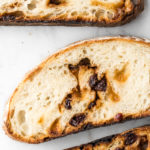
Leave a Reply